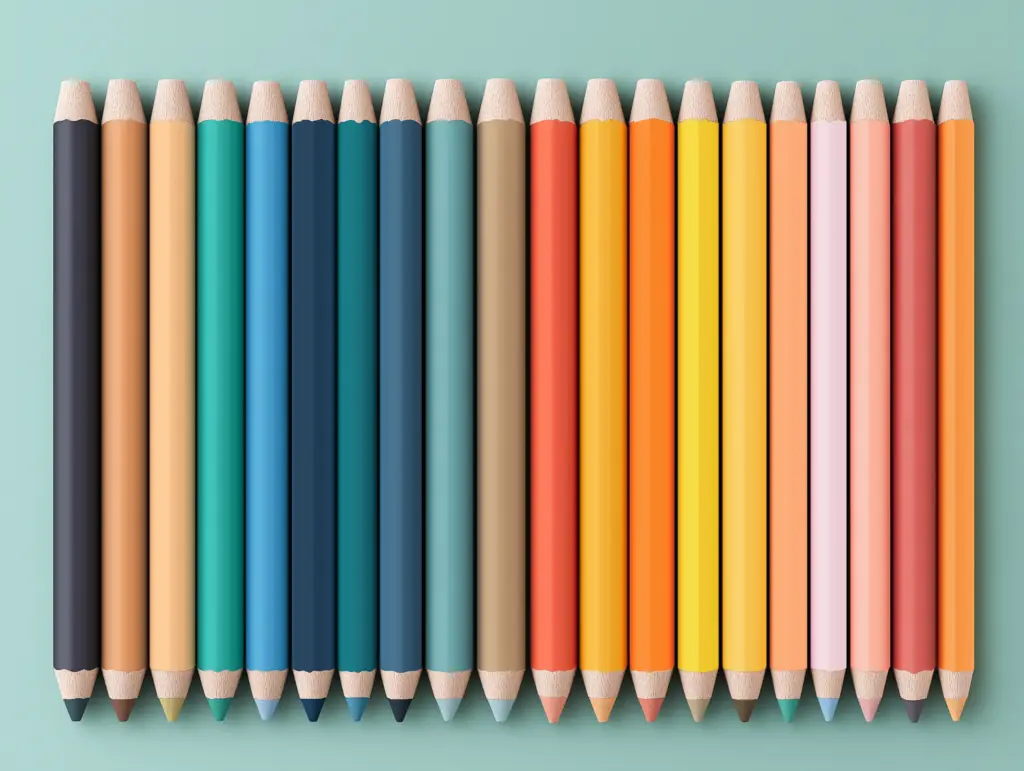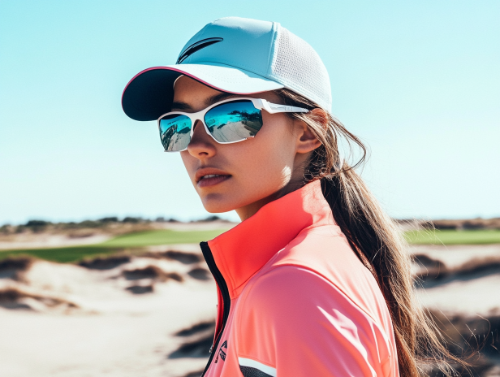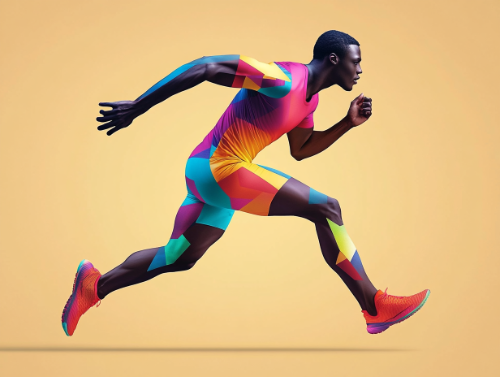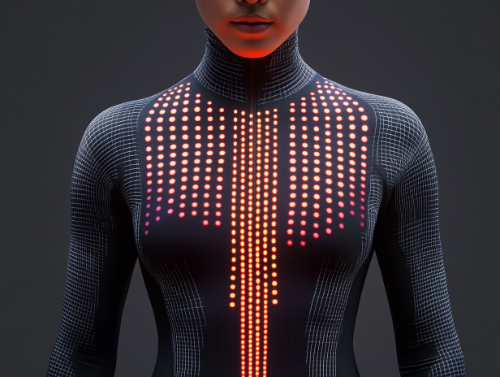Colours in sport transcend aesthetics; they create identities, arouse emotions and influence performance. Their use has evolved over time, revealing not only societal trends but also technological innovations. The evolution of colours shapes and categorises a unique visual culture, by sport. For example:

1. Football is all about symbolism and fervour.
Football is a global sport par excellence, and its colours are often associated with regional and cultural symbols. Clubs such as FC Barcelona and Manchester United use iconic colours to create a strong, unifying identity, where indigo and red not only evoke a sense of belonging, but also passion.
2. Athletics is a symbol of vivacity, dynamism and performance.
Athletics clothing has developed to incorporate bright, neon, almost fluorescent colours, increasing visibility and reflecting the energy and speed of the sport. Competitions make a lasting impression with their explosion of bright colours under the stadium lights.
3. Basketball as close as possible to its cultural and fashion influences.
Basketball, with its strong links to urban culture and streetwear, has seen its jerseys become fashion icons, influenced by renowned designers. The colours of teams like the Los Angeles Lakers (purple and gold) symbolise not only their success but also their flamboyant style of play.
4. Tennis stands for fair play, elegance and tradition.
In tennis, the use of colours has long been framed by a strict tradition (such as white at Wimbledon), but today bold colours and innovative patterns are beginning to redefine players' outfits, illustrating the constant evolution of the sport.
5. Rugby for strength and heritage.
In rugby, colours generate an intense sense of belonging while honouring history. New Zealand's All Blacks, with their iconic black uniform, create an aura of mystique and strength.
6. Golf with sophistication, elegance and professionalism.
Golf incorporates sophisticated colours, combining aspects of fashion and subtlety. Recent tournaments have seen golfers adopting bolder palettes, enhancing their professionalism while injecting personality.

Colour in sport transcends trends. It shapes identities, keeping pace with technological revolutions while preserving traditions. The future holds more exciting innovations as sports continue to grow, incorporating as yet unimagined palettes to push back the boundaries of sporting expression. The trends for 2025 are here to remind us.

The Power of Colour in Sport :
In 2025, the sports industry is at the forefront of fashion and technology, and colour is a central pillar. Sports facilities are no longer just performance tools; they are means of expression, cultural connection and environmental engagement. At the intersection of aesthetics, technological innovation and social movements, colours now define playing fields as much as those who operate on them.
1. Durability Dictating Chromatics
The rise of ecological awareness is redefining colour palettes in sport. The major brands are incorporating natural dyes and recycled materials into their products. Leafy greens, ocean blues and terracotta browns mark the new collections, symbolising a reconciliation with nature. Industry pioneers such as Patagonia and Nike are experimenting with biodegradable clothing and less toxic chemicals, underlining a move towards transparency and responsibility.
One example is the 'Earthrise' range developed by Nike, which uses seaweed-based dyes and adopts natural shades of green to evoke a land-sea connection.
2. Real-Time Customisation: Towards Adaptive Chromatics
Thanks to advanced technologies, sportswear becomes interactive, changing colour according to the circumstances. The integration of intelligent fibres and micro-sensors allows colours to react to body temperature, physical effort or even the emotions of athletes, creating a new dynamic between performance and appearance.
For example, Adidas has developed a prototype shoe that subtly changes colour according to heart rate, encouraging a sensory connection between the athlete and the equipment.
3. Retro Revisited: Re-interpreting Classic Colours.
Retro inspirations continue to have a powerful influence on contemporary trends. Vintage is making a strong comeback, but with a modern twist. Evocations of the 80s and 90s are evident in bold, saturated palettes reworked for today's taste. Combining the past with the present allows new generations to discover the sporting heritage while benefiting from the latest advances in design and comfort.
Puma's launch of its "Heritage Remix" line is a case in point, where the classic bright colours of the 80s are contrasted with contemporary graphics.
4. Local Culture and Globalisation: Hybrid Colours.
Globalisation is intensifying, influencing sports teams and products, and bringing cultural diversity to the fore. Sports brands are working with local artists and designers to include cultural motifs in their designs. This reduces the distance between the global and the local, allowing for authentic and rich cultural expression.
A notable case in point is New Balance's 'Continental Tones' collection, which teams up with indigenous artists to design colourful ranges inspired by tribal motifs.
5. Beyond Aesthetics: Psychology and Performance.
The psychological influence of colours on sporting performance is now well understood and actively applied in equipment design. Red is used to stimulate energy and competition, while green calms and centres the mind during critical moments of concentration. This explains why many competitive uniforms in 2025 are designed to maximise not only the style but also the mental state of the athletes.
Football teams such as Bayern Munich include consultations with sports psychologists to optimise their uniform palette, seeking to capitalise on the subtle psychological benefits.
6. Collaborative Practices: Artists and Sportsmen Hand in Hand.
The future of sports colours is not being forged by brands alone, but by collaboration between artists, athletes and designers. These partnerships allow each player to bring their unique contribution to the table, creating products that are visually appealing and emotionally inspiring.
An example of this is Reebok's collaboration with artist Yinka Ilori, who transforms cultural motifs into wearable art, fusing African influences with cutting-edge technology.
Towards an Unprecedented and Interconnected Horizon.
Colours in 2025 merge past, present and future to develop a new perspective on sport. They represent not only a tool for individual expression but also a growing awareness of a sustainable and socially responsible world. As our technological tools advance and our cultural sensibilities are enriched, the way we perceive and use colour continues to evolve, promising exciting innovations and creative revolutions at the crossroads of sport and fashion.

References :
-
To explore further the relationship between technology and sports fashion: "Designboom" and "Wired".
-
On ecological awareness and innovation: "Sustain Your Style" and the GreenPeace report on sustainable fashion.
-
For in-depth socio-cultural research on sports fashion: "The Journal of Sports History" and the "Vogue Business" archives.
These sources offer a variety of perspectives from which to understand the evolution of colour trends in sport and enrich our understanding of the current and future context.
